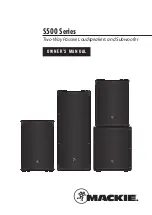
OPERATIONS AND MAINTENANCE MANUAL
RBS TRITON™ 35 SKIMMER
8
Booms can be used with RBS
RBS TRITON™ skimmers to help concentrate the oil
around the pick up area. ASTM adaptors are available through Aqua-Guard.
3.2
SHUT-DOWN
To conclude the oil recovery operation, the brushes should be stopped, then the transfer
pump should be allowed to empty the small central sump. Some oil will remain in the
sump after pump has shut off.
Turn off both the power pack and pump engines.
Raise the
RBS TRITON™ skimmer head from the water and place it on a plastic tarp or
bed of oil sorbents. Disconnect the suction hose and hydraulic hoses from the skimmer
head. Drain the remaining oil from the sump through the drain plug, collecting the oil in a
proper container.
As much as 6 liters (1.6 gallons) of oil may remain in the sump.
Always clean the equipment as soon as possible after it has been used.
4
PERFORMANCES
4.1
RECOVERY RATE
The Aqua-Guard RBS
TRITON™ 35 skimmer will recover any floating oil that is fluid at
ambient temperatures.
The recovery rate is governed by:
The brush speed, which is regulated from the power unit. As oil viscosity increases,
brush speed may be increased to increase the rate of recovery.
The viscosity of the oil. Very light oils and very heavy oils are recovered at lower rates
than those of intermediate viscosity. Very light oils only form thin films on the brushes,
while very thick oils do not flow down the tubes fast enough to clear the brush area.
The thickness of the oil slick being recovered. A thin film of oil can only be recovered
at a rate governed by the rate at which the oil will flow into the path of the brush. If the
oil film is thick enough to submerge the lower edges of the brush completely, the
recovery rate is maximized.
The degree of emulsification of the oil. Highly emulsified oils decrease the volume of
oil recovered. This is due to the water film, which is present after emulsification,
hindering the adhesion of the oil to the brushes.
4.2
MAXIMIZING RECOVERY
Efforts to maximize the thickness of the oil film will result in higher recovery rates.
Film thickness may be increased by the following:
Reducing the area enclosed by the containment boom
Towing the boom in a catenary curve against the current or wind, depending on which
one gives the greatest effect
Avoiding any actions which increase the degree of emulsification
Summary of Contents for RBS TRITON 35
Page 18: ......
Page 19: ......
Page 20: ......
Page 21: ......
Page 22: ......
Page 23: ......
Page 24: ......
Page 25: ......
Page 26: ......
Page 27: ......
Page 28: ......
Page 29: ......
Page 30: ......
Page 31: ......
Page 32: ......
Page 33: ......
Page 34: ......
Page 35: ......
Page 36: ......
Page 37: ......
Page 38: ......
Page 39: ......
Page 40: ......
Page 41: ......
Page 42: ......
Page 43: ......
Page 44: ......
Page 45: ......
Page 46: ......
Page 47: ......
Page 48: ......
Page 49: ......
Page 50: ......
Page 51: ......
Page 52: ......
Page 53: ......
Page 54: ......
Page 55: ......
Page 56: ......
Page 57: ......
Page 58: ......
Page 59: ......
Page 60: ......
Page 61: ......
Page 62: ......
Page 63: ......
Page 64: ......
Page 65: ......
Page 66: ......
Page 67: ......
Page 68: ......
Page 69: ......
Page 70: ......
Page 71: ......
Page 72: ......
Page 73: ......
Page 74: ......
Page 75: ......
Page 76: ......
Page 77: ......
Page 78: ......
Page 79: ......
Page 80: ......
Page 81: ......
Page 82: ......
Page 83: ......
Page 84: ......
Page 85: ......
Page 86: ......
Page 87: ......
Page 88: ......
Page 89: ......
Page 90: ......
Page 91: ......
Page 92: ......
Page 93: ......
Page 94: ......
Page 95: ......
Page 96: ......
Page 97: ......
Page 98: ......
Page 99: ......
Page 100: ......
Page 101: ......
Page 102: ......
Page 103: ......
Page 104: ......
Page 105: ......
Page 106: ......
Page 107: ......
Page 108: ......
Page 109: ......
Page 110: ......
Page 111: ......
Page 112: ......
Page 113: ......
Page 114: ......
Page 115: ......












































